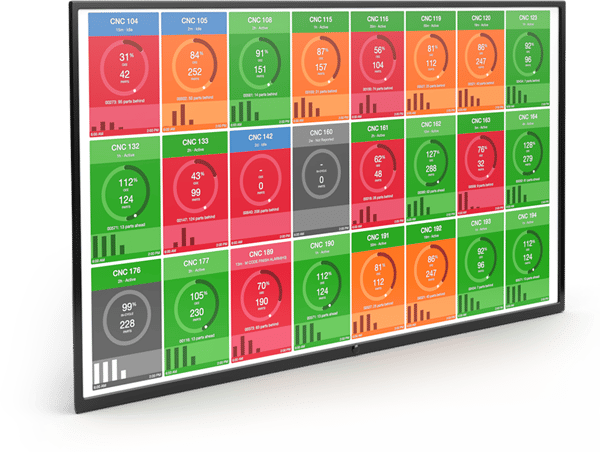The manufacturing industry is a leader among data collectors. Sensor data, employee movement tracking, downtime data, predictive maintenance-related data, demand—there are a lot of opportunities to collect information within a manufacturing facility.
On one hand, this sounds like a great thing. With all of that data, manufacturers should be able to better tailor products and services using increasingly narrow customer segmentation, utilize machine learning to reduce risk and guide decision-making through analysis and scenario-building, and even better understand which products and services they should offer next. Right?
Unfortunately, this is not the case. Despite being top data aggregators, many manufacturers are struggling to use the data to any real effect. With so many advantages to using the data, why are manufacturers falling behind the tech curve, and in such a hard-hitting way?

Why Manufacturing Data Goes Unutilized
In order to discuss a solution, let’s start with the problem. Why aren’t manufacturers effectively utilizing the data they collect? What’s stopping them?
In the broadest sense, it comes down to being outdated. Everything from employee skill sets to architecture is struggling to mesh with modern technology. While many manufacturers have added a thin veneer of digital transformation by adding IoT sensors and similar devices, the truth is that the core of manufacturing has oftentimes failed entirely to keep up meaningfully. It’s not necessarily a matter of clinging on to old ways out of an attachment to traditional methods, but rather the lack of energy and forethought needed to perform the type of overhaul that will guarantee continued business.
For some manufacturers, however, the time for make-or-break decisions is now, lest they be swept away by the currents of time, overcome by their more technologically-savvy competitors.
Data Silos
The data collection devices in use by many manufacturers are humming along, collecting the information they should be, but that data is being funneled directly into silos, and data silos don’t work, especially with massive amounts of incoming information. This means that some data is being sent to operations to manage and analyze, other data is being sent to procurement, or QA, or another department altogether. “Well, we can’t just throw everything at everybody!” outcries many a manufacturer.
Well, to counter that, yes you can. You both can and should. Siloed data is messy and unproductive—it often leads to multiple teams working separately on the same problems, departments having disparate and outdated data, and just a general disconnect from working as one cohesive organization.
Aging Workforce
The unflinching truth is that manufacturing is full of aging employees that were trained for an entirely different era in manufacturing history, and their influence continues to echo through policy and priority. The IT skills necessary for running a smart factory are not things they have trained for, and the thought of implementing these types of technology can seem overwhelming and uncomfortable (albeit less uncomfortable than the company going out of business).
Old Factories
Some factories operating today are practically derelict compared to modern “smart” options, and they have little support for a change to newer equipment. The machinery is old, just as the architecture and infrastructure of these factories is old. The logistics of operating a fully-connected shop floor can seem out of reach, especially if decision-makers are only aware of earlier forms of automation and data collection, such as the use of sensors that require manufacturers to void the warranties of precious machinery.
Ancient Processes
While factory floors are cramped and aging, the processes for operations and data collection are starting to crumble under the weight of the data they are collecting. Some manufacturers utilize an ad hoc process here and a quick-fix there, but this patchwork of solutions only creates a bigger problem as the data-led economy grows. Manufacturing processes founded in the past industrial era must be transformed to match the demands of a smart facility, but change can be both uncomfortable and intimidating. These processes serve to hold manufacturers back from using any of the data they collect.
Absent DataOps
In a ReThink Data report, it becomes clear that many manufacturers are severely lacking in data strategy and implementation. One major factor in this struggle is the absence of DataOps. Only 10% of organizations reported having full DataOps, and two-thirds of manufacturers had no DataOps at all. Without this initiative to strategize and bring together the collection, data, and tools to extract meaning from all of the effort, the disconnects remain and the data nightmare continues.
How To Maximize Manufacturing Data For Competitive Advantage
For manufacturers that have already begun implementing some smart technology like IoT and edge computing devices, the first step is to hire people for DataOps. These people will connect the data to the people and their decisions. They are the foundation of actually using the data you collect and using it well. These will be your go-to people for AI, machine learning, edge computing, and cloud-based data management.
Next, give that DataOps team the information they need. Knock down your data silos and see the connections and patterns and insights that can be extrapolated when the algorithms can see the full picture, and how much time departments reclaim by collaborating rather than working redundantly behind closed doors.
With all that data, you’re going to need a way to manage it and store it so it is readily accessible when it’s time to use it. This is among the top five barriers to data utilization according to the aforementioned ReThink Data report. You also have to find a way to keep it all safe and secure, since manufacturing data often contains proprietary information. MachineMetrics offers solutions on this front including an automated data transformation engine that standardizes data structures for consistent reporting and analytics. We also offer edge computing devices and convenient, scalable, instant transfer to the cloud for storage and analysis using only the best and most up-to-date security protocols and encrypted data transfers.
Last but not least, it’s important to develop a workplace culture that is positive and inviting toward data usage. For example, MachineMetrics lets factory floor workers input data on tablet devices directly at the machinery to add layers of human context to the data collected. This type of interactivity as well as real-time reporting, less downtime, and fewer broken tools and scrap parts leads to employees readily embracing a data-led culture.
Ready to learn more about how the MachineMetrics IoT platform can help your company collect, analyze, and store your manufacturing data? Book a demo with us here.



.png?width=1960&height=1300&name=01_comp_Downtime-%26-Quality_laptop%20(1).png)



.gif)









Comments